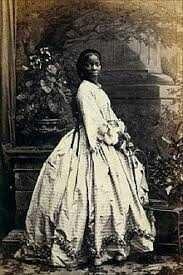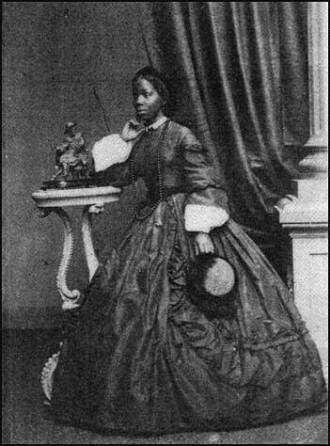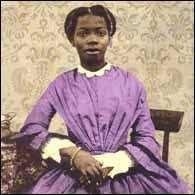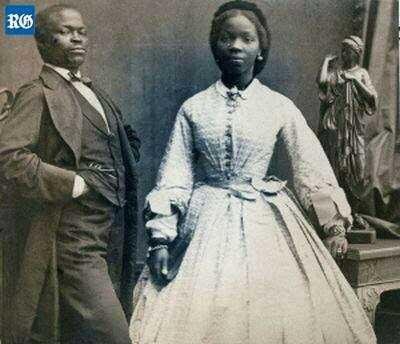Sarah Forbes Bonetta Davies, a Yoruba girl from Egbado in present day Ogun State, was captured by the King of Dahomey in 1848 during a "slave-hunt" war in which her parents were killed. In 1850, when she was around eight years old, she was rescued by Captain Frederick E Forbes of the Royal Navy whilst he was visiting Dahomey as an emissary of the British Government.

Forbes convinced King Ghezo of Dahomey to give Sarah to Queen Victoria saying: "She would be a present from the King of the Blacks to the Queen of the Whites." The young girl was subsequently given the name Forbes as well as that of his ship, the 'Bonetta'.
She returned to England with Forbes who presented her to Queen Victoria, who in turn gave her over to the Church Missionary Society to be educated. Sarah suffered from fragile health and in 1851 she returned to Africa to attend the Female Institution in Freetown, Sierra Leone.
When she was 12 years old, Queen Victoria commanded that Sarah return to England, where she was placed under the charge of Mr and Mrs Schon at Chatham.
Queen Victoria was so impressed by the girl's natural regal manner and her gift for academic studies, literature, art and music that she gave her an allowance for her welfare and Sarah became a regular visitor to Windsor Castle. Sarah's genius became admired throughout the royal court and she continued to outshine her tutors with her advanced abilities in all studies.
At the age of 18, Sarah received a proposal from James Pinson Labulo (JPL) Davies, a 31-year-old Yoruba businessman of considerable wealth who was living in Britain. He was a great man, a school teacher, naval officer, mariner, merchant and the pioneer of cocoa farming in Africa as well as an industrialist. He was one of the most successful West Africans of the nineteenth century.

He also funded and helped establish CMS grammar school in Lagos, having himself been privileged to attend another CMS grammar school in Freetown, Sierra Leone in 1848. “From his political activism in the face of imperial opposition and success in international trade to his celebrity wedding, there was so much to distinguish the life of JPL Davies”
She initially refused his proposal and it is reported that in order to persuade her to accept Sarah was sent to live with two elderly ladies in Brighton whose house she described as a "desolate little pig sty".
Queen Victoria sanctioned Sarah to be married in St Nicholas Church in Brighton in August 1862 in a lavish wedding. The wedding party, which arrived from West Hill Lodge, Brighton in ten carriages and pairs of grays, was made up of "White ladies with African gentlemen, and African ladies with White gentlemen" There were sixteen bridesmaids.
The newlyweds moved back to West Africa and Sarah was baptised at a church in the town of Badagry, a former slave port. They settled in Lagos where her husband became a member of the Legislative Council from 1872-74 (in which year Lagos Colony was for a time amalgamated into the Gold Coast).
Shortly after her marriage, Sarah gave birth to a daughter and was granted permission by the Queen to name the child Victoria - the Queen also became her Godmother. Our popular Victoria Island in Lagos, was named after her by her Godmother, as a gift. A solid gold christening set presented to Victoria by the Queen with the inscription, “To Victoria Davis from her Godmother Victoria Queen of Great Britain and Ireland 1863” remains with her family in Lagos to this day.
Sarah visited the Queen in 1867 with her daughter then returned to Lagos and had two more children. Later, upon Sarah's death the Queen wrote in her diary: "Saw poor Victoria Davies, my black godchild, who learnt this morning of the death of her dear mother". So proud was Queen Victoria of Sarah's daughter, that when she passed her music examination, teachers and children had one day holiday.
Throughout her life Sarah had a long-lasting cough that was caused by the climate change between Africa and Britain. In 1880, suffering from tuberculosis, she went to convalesce in Madeira, Portugal. She died, around the age of 40, in 1880 and was buried in Funchal, Madeira, Portugal.

After her mother’s death, Victoria was taken back to her God-mother, Queen Victoria’s care, who gave her a life-long allowance of £40 per annum, at today’s value of £4,667 (equivalent to N2.37Million). She continued to visit the royal household throughout her life. She was educated at the exclusive Cheltenham Ladies' College
Victoria Davies herself married Dr. John Randle, at St. Paul’s Church, Breadfruit Lagos in November 1890. Her wedding dress was a gift from Queen Victoria. The famous educator/administrator Henry Carr was the best man.

Her husband, Dr John Randle was one of Nigeria’s pioneer medical doctors having qualified at Edinburgh University Scotland where he won the Gold Medal for surgery in 1888 and practiced for many years at his mansion cum surgery at 31 Marina, Lagos. He died in 1928 at the age of 73. He devoted much of his life to public health, public service and philanthropy. He was also founder of one of the earliest political parties in Nigeria – The Peoples Union in 1908. The famous landmark, Randle Avenue, in Lagos, was named after him.
Hi! I am a robot. I just upvoted you! I found similar content that readers might be interested in:
https://www.facebook.com/doni.glover/posts/2005428429715349
Downvoting a post can decrease pending rewards and make it less visible. Common reasons:
Submit